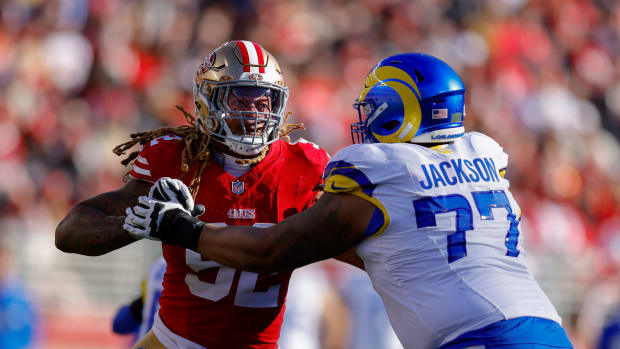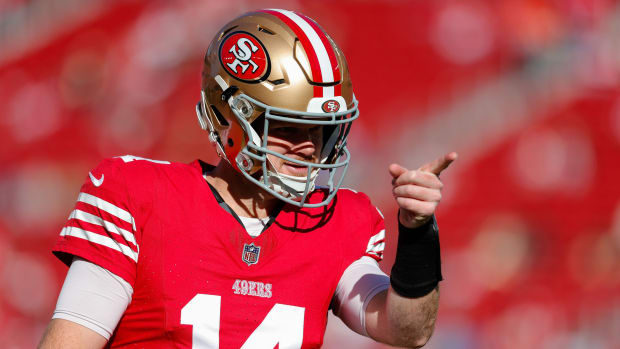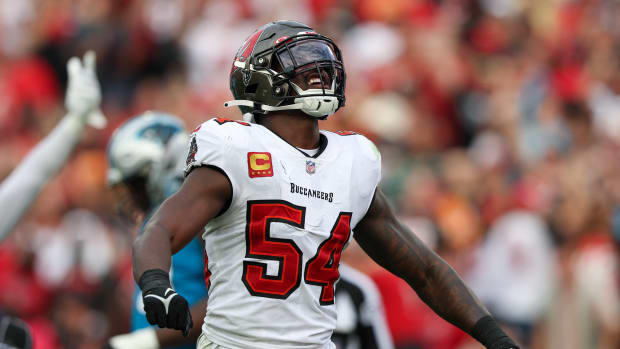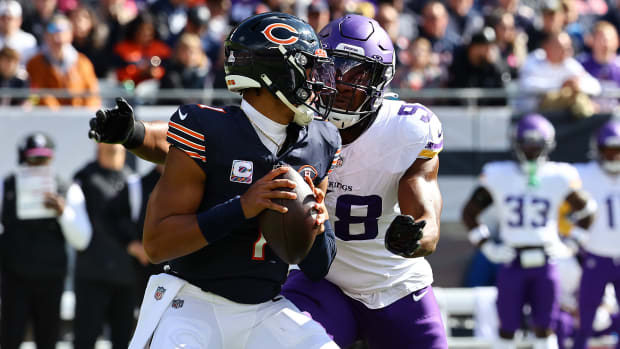He’s No Regular Joe
Joe Flacco is the most underappreciated quarterback in football—by far. He’s an elite superstar blessed with all the physical traits you look for: size, arm strength, precision accuracy, and even mobility. Though he’s not “off the charts” in the latter category, he’s much better at moving than his gangly frame suggests. These characteristics enable the eighth-year veteran to fit the ball into the tight windows, a requirement for beating man coverage in the NFL. Flacco is also cerebral, which shows in the way he identifies and picks apart defensive zones.
And for those who believe in the old barroom debate about who’s a “winner” and who’s not, Flacco checks out as strong as any QB in the league. His 10-5 postseason record is the best among all active quarterbacks not named Tom Brady. Seven of those victories have come on the road, an NFL record. On his way to winning a Super Bowl at the end of the 2012 season, Flacco had arguably the best postseason of any passer ever: 11 touchdowns, 0 interceptions, 285 yards a game and a much-deserved MVP award in the end. (The only other similar playoff run was Joe Montana’s in 1989: in three games he threw 11 touchdowns and 0 interceptions, averaging 267 yards an outing.)
Flacco’s biggest problem is one of perception, because he comes across as bland. But if you listen to what he says and not how he says it, you realize that he’s thoughtful, refreshingly honest and eloquent—yet he continues to get overlooked and underestimated. Maybe that will change this season during Super Bowl 50 Media Day. If all goes right, that’s where his Ravens will end up.
Known for their perennially stingy defense, the Ravens are now coming off the most prolific offensive season in the franchise’s 19-year history. Sure, Gary Kubiak left to become the head coach in Denver, meaning the Ravens will have a new offensive coordinator for the fourth time in four years (dating back to Jim Caldwell replacing Cam Cameron at the end of 2012), but John Harbaugh found the best replacement he could in Marc Trestman. Like Kubiak, Trestman is a former head coach who, if necessary, can oversee every aspect of his side of the ball. Trestman takes a very intellectual approach to the game and, at least by NFL coaching standards, has virtually no ego. He won’t undo Kubiak’s highly successful zone-based system.
In that zone system, the Ravens ran the ball with regularity and operated out of two running back personnel more than any team last season. By an incredibly wide margin, they had the fewest shotgun snaps in the league. Justin Forsett, who tied DeMarco Murray for the most 20-plus-yard carries, picked up at least 10 yards on 17 percent of his carries, the highest rate in the NFL. Forsett, who re-signed in the offseason for $9 million over three years, has very good patience and vision, particularly when attacking the perimeter, which is the key to Baltimore’s zone stretch game. From these zone stretches come a litany of misdirection play-action possibilities, which is why the aerial attack is not constructed around the shotgun.
Forsett has a near-perfect zone-oriented front five paving his way. It starts with center Jeremy Zuttah, who at 300 pounds masks his so-so raw strength with good quickness, both off the snap and in his immediate subsequent steps. When Zuttah gets movement, the rest of the line follows. Flanking the eighth-year center is the league’s best guard duo, Kelechi Osemele on the left and All-Pro Marshal Yanda on the right. On the edges, Eugene Monroe is sturdy at left tackle and 2013 fifth-rounder Ricky Wagner is fast becoming a premier right tackle.
While Trestman will maintain much of Baltimore’s existing ground game, he should also work in some of his own innovations. This would come most appropriately through the air, where Trestman is a shrewd designer of downfield route combinations, particularly out of tight receiver sets. He has the diminutive-but-still-lethal Steve Smith and the gifted-but-likely-raw first-round rookie Breshad Perriman (6’2”, 212). Expect to see a little more of the West Coast concepts that Trestman employed in the early 2000s, when he was Jon Gruden’s QB’s coach/offensive coordinator in Oakland.
Second-round rookie Maxx Williams, this draft’s highest-rated tight end, will give the Ravens the seam threat that Crockett Gillmore doesn’t offer (he’s more of a blocker). Both men will see action each week, but if Trestman maintains much of Kubiak’s ground concepts, their action often won’t come simultaneously; one of the tight ends would have to sit in order to make room for fullback Kyle Juszczyk, a tremendous lead-blocker and trustworthy pass-catcher in the shallow flats.
The only concern with this offense is depth at the skill positions, but Flacco’s excellence can offset that. (Slot receiver Michael Campanaro, for example, developed very good chemistry with his quarterback down the stretch last season.) However you slice it, this is a talented Ravens offense, operating in a good scheme, under a very smart coach, and on the shoulders of one of the game’s elite superstar quarterbacks. There’s your Super Bowl formula.
Ravens Nickel Package
1. Rarely does a strong offense alone lead a team to a Super Bowl. Fortunately, the Ravens aren’t relying on just that. GM Ozzie Newsome has once again infused his defense with considerable talent at all three levels. The biggest question is whether the front seven can overcome the losses of Haloti Ngata (traded to Detroit) and hybrid sub-package rusher Pernell McPhee (signed with Chicago). The short answer is yes. Newsome dealt the five-time Pro Bowl defensive lineman because he’d seen enough positive signs from Timmy Jernigan, last year’s second-round pick. Like Ngata, Jernigan can play multiple positions (except for maybe true nose tackle). As a rookie he flashed an ability to disengage from blocks. As for McPhee’s replacement, fourth-round pick Za’Darius Smith is unlikely to be as versatile or explosive as his predecessor. But with improvements in the secondary, defensive coordinator Dean Pees can expand his pressure packages. Pees may also get more creative with the versatile Courtney Upshaw. Plus, he still has Terrell Suggs and Elvis Dumervil, who haven’t lost a step in their early 30s and combined for 29 sacks last season.
2. Regarding the aforementioned improvements in the secondary, the biggest is the return to health of cornerback Jimmy Smith, who can shadow No. 1 receivers. If not for Smith’s foot injury last November, it very well could have been the Ravens winning that epic divisional round Saturday evening game and not the Patriots. Assuming Lardarius Webb gets on track (he publicly griped about his job security over the offseason and then failed his physical at the beginning of training camp), the Ravens have options in the slot—a position that, due to injuries, hurt the club down the stretch. Either Webb plays there or offseason pickup Kyle Arrington does. With the flexibility that both offer, Pees can now match his corners on specific wide receivers on a weekly basis.
3. Learn the name Brandon Williams. The 2013 third-round pick has been absolutely sensational at nose tackle. With Haloti Ngata gone, maybe people will now notice.
4. You probably already know linebacker C.J. Mosley, who is on course for stardom. He’s quick in confined areas, athletic in space (expect that to be better reflected in his coverage this season) and has a keen sense for pursuit angles. Mosley benefits from playing alongside veteran Daryl Smith, one of the game’s most professional linebackers.
5. With a dynamic front seven, Pees can afford to keep both safeties back deep, even on first and second down. (This was how he masked the deficiencies of his injury-riddled secondary late last season.) With Matt Elam out for the season (biceps), one of those safeties will surely be Will Hill. He was probably going to start ahead of Elam anyway. Available to sign last year because of various off-field problems, Hill showed a unique blend of size and physicality for someone who could also cover tight ends man-to-man. And it wasn’t just any tight ends; he gave fits to the likes of Jimmy Graham and Antonio Gates in consecutive weeks.





































